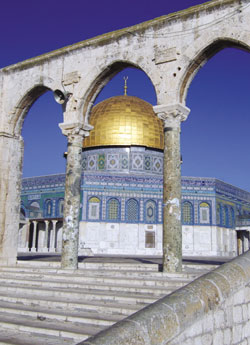Archbishop Buechlein will lead pilgrimage to the Holy Land

The Dome of the Rock is in the center of the Temple Mount in Jerusalem. (File photo)
Criterion staff report
In preparation for the Archdiocese of Indianapolis’s 175th anniversary celebration in 2009, Archbishop Daniel M. Buechlein will lead a pilgrimage to the Holy Land from Sept. 17-27.
“We went [to the Holy Land] 10 years ago, and the archbishop always said that he would like to be able to return,” said Carolyn Noone, associate director of special events for the archdiocese.
“It’s a life-changing experience to be able to walk where the Apostles walked, to visit the temple where Jesus first preached and to see [the Virgin] Mary’s home,” Noone said.
The pilgrims will leave Indianapolis on Sept. 17 and arrive the next day in Tel Aviv, Israel.
The day will include a stop at the ancient port of Joppa, where the Apostle Peter raised Tabitha from the dead. Joppa, according to tradition, is also the port where Jonah departed after God instructed him to go to Nineveh and witness to the citizens of the city considered one of the most wicked of ancient times.
The next day, the pilgrims will visit Caesarea, one of the most beautiful cities of the ancient world. St. Paul was imprisoned there before he sailed to Rome for his trial and execution.
Later that day, the pilgrimage will continue to Haifa then to the ancient town of Cana, where Jesus performed his first miracle at a wedding there. At a Mass in Cana, couples will be invited to renew their wedding vows.
On Sept. 20, the pilgrims will visit the city of Sepphoris, which tradition holds is the birthplace of the Blessed Mother. They will also visit Nazareth, the boyhood home of Jesus. Mass will be celebrated in the grotto of the Basilica of the Annunciation there.
Later that day, the pilgrims will travel to Kibbutz Nof Ginosar, where a fishing boat dating back to the time of Christ has recently been excavated from the Sea of Galilee. They will board a boat there and sail back to Tiberias.
The next morning, the pilgrims will travel to Capernaum, a lakeside village frequently referred to as home to St. Peter and the area used by Jesus as his “home” during his public ministry.
The pilgrims will also visit Tabgha, the site of the multiplication of the loaves and fishes. Next, they will visit the Mount of the Beatitudes, which marks the location of Jesus’ Sermon on the Mount.
On Sept. 22, the pilgrims travel into the Jordan Valley to view Jericho, the oldest known inhabited city of the Western world and the site of Joshua’s first dramatic conquest when the city walls collapsed at the sound of the Israelites’ trumpets.
Later that day, the pilgrims will drive to Bethlehem, the birthplace of King David and Jesus. Mass will be celebrated at Shepherds’ Fields, where those tending their sheep first learned of the birth of Christ.
The next morning, the pilgrims will ascend to the top of the Mount of Olives to enjoy a breathtaking view of Jerusalem. On the Mount itself, pilgrims can visit the Church of Pater Noster, Dominus Flevit and the Chapel of the Ascension. Mass will be celebrated in the Garden of Gethsemane.
On Sept. 24, the pilgrims descend through the Judean Desert to the Dead Sea, the lowest point on the surface of the Earth that is dry land. En route, they will visit the Inn of the Good Samaritan. On the return trip to Jerusalem, the pilgrims will pass Qumran, the caves where the Dead Sea Scrolls were found between 1947 and 1979.
The next morning, the pilgrims will travel to Ein Karem, the birthplace of St. John the Baptist, and will celebrate Mass at the Church of the Visitation. They will visit Mount Zion to see the Upper Room. They will view the Pool of Siloam then stop at Caiaphas’ House (St. Peter in Gallicantu).
They will also drive to the Israel Museum complex to visit the Shrine of the Book, which houses the original manuscripts of the Dead Sea Scrolls.
On Sept. 26, the pilgrims enter Jerusalem again through St. Stephen’s Gate. They will visit the Crusader Church of St. Anne and the Pool of Bethseda, where Jesus healed a lame man.
After viewing the Arch of Ecco Homo and the Convent of the Sisters of Zion, the pilgrims will follow the Via Dolorosa to the Holy Sepulchre, where Mass will be celebrated in the Roman Catholic Chapel. They will later have the opportunity to drive to the Arab Village of Abu Ghosh, considered to be the site of Emmaus, where Jesus appeared after the Resurrection.
“To walk in the Old City [Jerusalem], because many of its sites exist as they did back then, to see the vendors, to walk the Via Dolorosa, to visit the Church of the Holy Sepulchre” is an unforgettable experience, Noone said.
On Sept. 27, the pilgrimage group departs for Indianapolis.
For those considering the Holy Land pilgrimage, Noone reiterated that it will be a moving experience.
“It will bring your faith to life,” she said.
The cost of the trip, which includes air fare, hotels, some meals, sightseeing fees, transportation and a tour guide, is $3,955 for a double room and $4,600 for a single room.
(For more information about the pilgrimage or to receive a brochure, call Carolyn Noone at the Archdiocese of Indianapolis at 317-236-1428 or 800-382-9836, ext. 1428, or e-mail cnoone@archindy.org.) †
